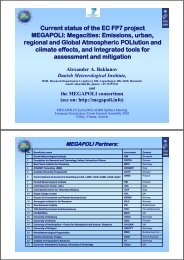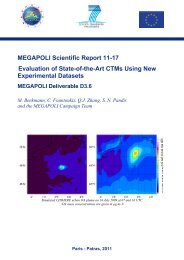D E S C R I P T I O N O F W O R K - MEGAPOLI - Dmi
D E S C R I P T I O N O F W O R K - MEGAPOLI - Dmi
D E S C R I P T I O N O F W O R K - MEGAPOLI - Dmi
Create successful ePaper yourself
Turn your PDF publications into a flip-book with our unique Google optimized e-Paper software.
<strong>MEGAPOLI</strong> 212520<br />
concentrates on enhancing the resolution of the emissions data and nesting the case study cities<br />
accurately in the global database.<br />
2) Regional Pan-European anthropogenic emission inventory :<br />
Complete Pan-European emission inventories and high resolution emission maps of primary<br />
anthropogenic pollutants at a resolution of about 6 x 6 km for the base year 2003 will be provided<br />
as inputs to the regional modelling activities in WP 5 and 6. Relevant emission characteristics<br />
important for improving the predictive capacity of the models will be improved and included where<br />
possible.<br />
3) Development of a baseline scenario:<br />
Baseline scenario for the years 2020 and 2030 and a rough estimate for 2050 for Europe and for the<br />
case study megacities (Paris, London, Rhine-Ruhr, Po Valley, Mexico City) will be provided as a<br />
basis for the analysis of emission reduction measures and strategies in WP 8.<br />
4) Case studies:<br />
High quality and high resolution city inventories will be compiled, based on existing information to<br />
the extent possible, and made available both as model input and a base for mitigation measures. The<br />
underlying activity data tables will be “translated” and linked in the various databases in order to be<br />
nested in a consistent way in the regional and global emission inventories.<br />
5) European heat flux inventory:<br />
To assess the impact of heat flux from megacities on local climate a European anthropogenic heat<br />
flux inventory will be developed using the activity data and spatial distributions from task 2,<br />
working with heat flux factors developed in cooperation with WP2.<br />
6) Validation, evaluation and improvement of EI’s:<br />
Task 1 and task 2 will start out with delivering a first working version of the desired inventories in<br />
the first year of the project. The EI’s will be further improved through: 1) feedback from modellers<br />
working with the EI’s; 2) A general review of regional source apportionment studies; 3) Validation<br />
through measurement data and source apportionment within WP3 and WP4.<br />
7) Processing of emission inventories for model sensitivity and scenario runs:<br />
Emissions datasets will be provided for the sensitivity runs (WP5) and future scenario runs (WPs 5,<br />
6 and 8). For the sensitivity runs, two types of emissions datasets will be provided: removing the<br />
total megacity emissions from the dataset, and redistributing a fraction of the megacity emissions<br />
into the surrounding regions.<br />
WP2: Megacity Environments: Features, Processes and Effects<br />
Overview and Background<br />
Megacities are localized, heterogeneous and variable sources of the anthropogenic impact on air<br />
quality and ultimately on climate. The major difficulty in megacity forcing in simulations arises<br />
from the sub-grid scale features. They are typically unresolved in climate models and barely<br />
resolved in regional scale models. Thus, models rely on parameterizations of megacity features<br />
aggregated within the model grid cell. Aggregation is not straightforward given surface<br />
heterogeneity and strong non-linearity of the turbulent transport in the urban atmospheric boundary<br />
layer (UABL). The latter prohibits the application of direct averaging to obtain the large-scale<br />
forcing. Albeit known since Schmidt (1921), the aggregation problems are still largely ignored in<br />
existing urban parameterizations. A more sophisticated approach which accounts for emission at<br />
16




